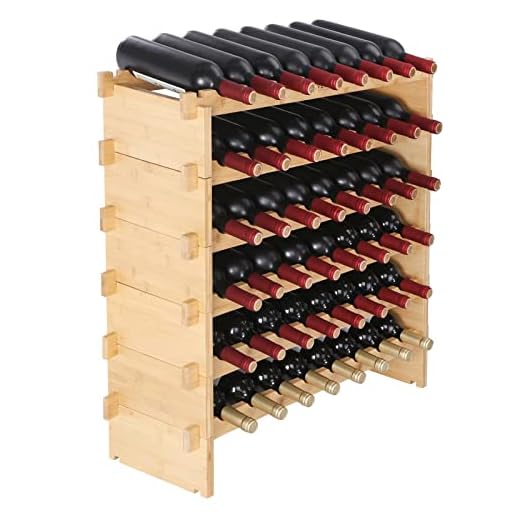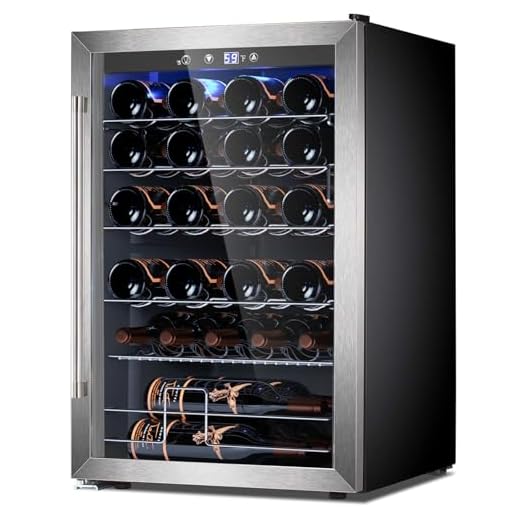



For the best preservation of red varietals, aim for a temperature range of 55°F to 65°F (13°C to 18°C). This environment allows the complex flavors and aromas to develop gracefully, ensuring a delightful experience upon opening the bottle.
Maintaining a consistent temperature is crucial. Fluctuations can lead to premature aging or spoilage. Avoid placing bottles near heat sources, such as kitchens or direct sunlight, as this can adversely affect the quality of the liquid.
Humidity levels also play a significant role. Ideally, aim for a humidity level around 60% to 70%. This prevents corks from drying out and allows for proper sealing, which is essential for preserving the integrity of the contents.
Consider investing in a dedicated wine refrigerator or cellar if possible. This will provide stable conditions tailored specifically for your collection, allowing your reds to reach their full potential over time.
Optimal Conditions for Storing Quality Bottles
Maintain a temperature range between 55°F and 65°F (13°C to 18°C) for optimal preservation of these beverages. Aim for a consistent environment, avoiding fluctuations that can negatively impact flavor and aroma.
Humidity levels around 60% to 70% help keep corks moist, preventing air from seeping into the bottles. A dedicated cellar or wine fridge can facilitate maintaining these conditions.
Light exposure should be minimized; ultraviolet rays can degrade the quality of the liquid. Dark storage spaces or tinted bottles are advisable to protect against light damage.
Vibration can disturb sediments and alter the wine’s maturation process. Choose a location that remains stable and undisturbed, away from appliances that generate vibrations.
Regularly check bottles for signs of leakage or cork degradation, as these can indicate improper conditions. Making adjustments to the storage environment as needed will ensure that the collection remains in prime condition for enjoyment.
Optimal Temperature Range for Red Wine Storage
The ideal range for keeping your favorite varietals falls between 55°F to 65°F (13°C to 18°C). This temperature zone promotes proper aging while preserving the wine’s character and complexity.
Factors Influencing Storage Conditions
Several elements can impact the effectiveness of this range:
- Humidity: Aim for a relative humidity of around 70%. This helps maintain cork integrity.
- Light: Keep bottles in dark or low-light environments to avoid UV damage.
- Vibration: Minimize movement; vibrations can disturb sediment and alter flavor profiles.
Recommended Storage Solutions
For optimal preservation, consider these options:
| Storage Type | Details |
|---|---|
| Wine Cellar | Consistent temperature and humidity control, ideal for long-term aging. |
| Wine Refrigerator | Portable units that maintain the desired climate, suitable for short to medium-term storage. |
| Underground Storage | Natural insulation and stable conditions, effective for traditional storage methods. |
By adhering to these guidelines, the integrity of your cherished bottles will be preserved, allowing for the best possible tasting experience. Happy sipping!
Impact of Temperature on Wine Flavor and Aroma
Storing at 55°F (13°C) is ideal for preserving the integrity of a bottle. At this temperature, the delicate balance between acidity, tannins, and fruit can be maintained, allowing the complexities of the wine to flourish. Higher temperatures, such as 70°F (21°C) or above, can accelerate the aging process, leading to premature oxidation. This results in a loss of freshness and vibrancy, transforming a once-pleasurable experience into a flat one.
Conversely, lower temperatures, around 45°F (7°C), may mute aromas and flavors. The wine can become overly chilled, suppressing its nuanced profiles, which are essential for a full tasting experience. For instance, a Cabernet Sauvignon stored too cold might lack the rich, bold characteristics that define it.
Temperature fluctuations can introduce stress to the wine. Rapid shifts can cause corks to expand and contract, allowing oxygen to seep in and spoil the contents. Consistent conditions are fundamental for the aging process, enabling the wine to evolve gracefully over time.
The impact on aroma is significant as well. At optimal storage temperatures, the volatile compounds responsible for aroma remain stable, allowing the wine to express its intended bouquet. When temperatures rise, the aromatic compounds can evaporate, diminishing the olfactory experience.
In summary, maintaining a stable environment within the ideal range ensures that the wine preserves its intended flavor profile and aromatic complexity. This approach enhances the overall enjoyment, allowing each bottle to present its unique story with clarity.
How to Measure and Control Wine Storage Temperature
Utilizing precise instruments is critical for gauging and managing the environment for your bottled treasures. Here are key methods to achieve accurate readings:
- Thermometers: Employ digital or infrared thermometers for instant and precise temperature checks. Ensure placement away from direct sunlight and drafts for reliable readings.
- Temperature Monitors: Invest in dedicated wine storage monitors that provide continuous tracking. Many models feature alerts for temperature fluctuations, ensuring timely adjustments.
- Smart Devices: Consider smart sensors that connect to mobile applications. These can send notifications to your phone regarding changes in temperature, allowing for quick action.
Controlling the climate in your storage space is equally vital. Follow these recommendations:
- Location: Choose a dark, cool area away from heat sources. Basements are often ideal due to their naturally stable temperatures.
- Cooling Systems: If necessary, install a wine refrigerator or cellar cooling unit designed for optimal conditions. Ensure it maintains the right range consistently.
- Insulation: Proper insulation for your storage area helps maintain a steady environment. Consider sealing any gaps or using insulated doors.
Monitoring humidity levels is also important. Aim for a range of 50-70% to prevent corks from drying out or mold growth. Use a hygrometer for accurate assessments and consider a humidifier or dehumidifier as needed.
Regularly reviewing these elements will enhance the preservation of your collection, ensuring each bottle is ready for enjoyment at its best.
Best Wine Storage Locations for Consistent Temperature
Basements are often ideal for maintaining a stable climate, thanks to their naturally cooler environment and insulation from outside temperature fluctuations. If a basement isn’t available, consider a temperature-controlled wine fridge, specifically designed to provide the necessary conditions for optimal aging. This option guarantees precise temperature regulation and humidity control.
Closets or under-stair spaces can also serve well, provided they are away from heat sources like radiators or direct sunlight. Ensure these areas are insulated and dark, as light exposure can deteriorate the quality of the wine. Storing bottles horizontally helps keep corks moist, preventing air from seeping in.
Additional Considerations
Monitor humidity levels; aim for around 60-70%. Excessive dryness can cause corks to shrink, while high humidity may promote mold growth. Utilizing a hygrometer can help maintain appropriate moisture levels. For those living in particularly dry or humid climates, investing in a dehumidifier or humidifier can be beneficial.
Lastly, consider vibration. Avoid placing bottles near washing machines, refrigerators, or other appliances that produce vibrations, as this can negatively impact the wine’s sediment and overall quality. For more information on maintaining household items, check out this link: can you safely clean tennis balls in the washing machine find out here.
Effects of Temperature Fluctuations on Wine Quality
Temperature variations can significantly damage the integrity of a bottle. Fluctuations beyond the optimal range can lead to accelerated aging, resulting in a degradation of flavors and aromas. Ideally, a consistent environment should be maintained to preserve the quality of the beverage.
For instance, brief increases in heat, such as exposure to direct sunlight or high ambient temperatures, can cause the liquid to expand and push the cork out, allowing oxygen to enter. This oxidation can lead to off-flavors and spoilage. Conversely, cold temperatures may slow down the aging process, potentially stunting the development of desirable characteristics.
Aiming for a stable environment mitigates the risk of damage. Frequent changes can disrupt the delicate balance of compounds within the bottle, leading to undesirable chemical reactions. A well-insulated storage area can help maintain an even temperature, protecting the contents from external influences.
Regular monitoring of the environment is advisable. Utilizing a reliable thermometer ensures that any unexpected changes are quickly addressed, thus safeguarding the wine’s quality over time. Aim for a consistent temperature to encourage the best possible expression of the varietal.
Common Myths About Red Wine Storage Temperatures
Storing this beverage at room temperature is a widespread misconception. Ideally, the environment should be cooler, around 55°F to 65°F. Temperatures above this range can cause premature aging and spoilage.
Another myth is that refrigeration ruins flavor. While serving temperature is crucial, short-term chilling can enhance aromas and tastes. Restoring to proper serving temperature after chilling is vital.
- Some believe that all varieties require the same climate conditions. In reality, different styles often have distinct needs. Lighter reds may thrive at slightly cooler conditions compared to full-bodied options.
- Another common fallacy is that wine only needs to be stored upright. In fact, keeping bottles horizontal helps keep corks moist, preventing air from entering.
- There’s a notion that once a bottle is opened, it must be consumed quickly. While oxidation occurs after opening, many bottles can last for several days with proper sealing methods.
Finally, many think that temperature fluctuations are harmless. In truth, consistent conditions are paramount; significant changes can adversely impact flavor profiles and overall quality.
Tips for Storing Red Wine Without a Wine Cellar
For optimal preservation of your favorite vintages without a dedicated cellar, keep bottles positioned horizontally to maintain cork moisture. This prevents air from seeping in and spoiling the contents.
Temperature Control Solutions
Utilize a wine fridge if possible, as these appliances maintain ideal conditions. If a wine fridge isn’t available, consider placing bottles in a closet or a dark corner of your home, away from sunlight and heat sources. Aim for a consistent temperature in the range of 50-65°F (10-18°C).
Humidity and Environment
Monitor humidity levels, ideally between 50-70%. Excessive dryness can cause corks to shrink, allowing air to enter. A small humidifier or a dish of water can help maintain necessary moisture. Avoid areas with significant temperature fluctuations, such as near ovens or heating vents.
Regularly check the environment where your bottles are kept. Dark, stable places will safeguard against light and temperature variations, both of which can compromise quality over time.
Lastly, keep your collection organized. Store bottles upright for short periods, but switch to horizontal as long-term storage. This method ensures that labels remain intact and easily readable.
FAQ:
What is the ideal temperature for storing red wine?
The ideal temperature for storing red wine is typically between 55°F and 65°F (13°C to 18°C). This range helps preserve the wine’s flavors and aromas, allowing it to age gracefully. If the temperature is too high, the wine may age too quickly and lose its characteristics. Conversely, storing red wine at too low a temperature can slow down the aging process significantly, which may prevent the wine from reaching its full potential.
How long can I store red wine at room temperature?
Storing red wine at room temperature is generally acceptable for short periods, such as a few days to a week. However, if the room temperature exceeds 70°F (21°C), it can negatively impact the wine’s quality. Prolonged exposure to high temperatures can result in cooked flavors and spoilage. For long-term storage, it’s best to keep red wine in a cooler, darker place where the temperature is more stable and within the recommended range.
Does the type of red wine affect the storage temperature?
Yes, the type of red wine can influence the optimal storage temperature. Lighter red wines, such as Pinot Noir, are often best stored at the lower end of the recommended temperature range, around 55°F (13°C). Full-bodied reds, like Cabernet Sauvignon, may benefit from slightly warmer temperatures, closer to 65°F (18°C). Ultimately, while the general range applies to all red wines, specific varietals may have slight variations based on their characteristics.











